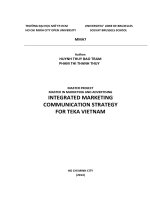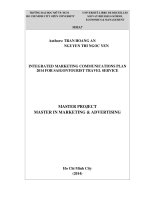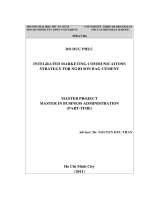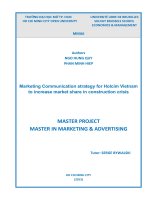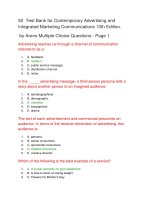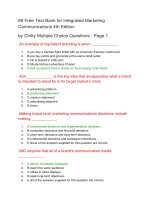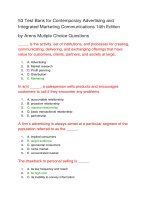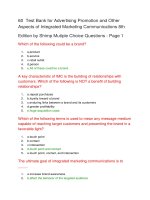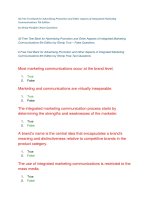Integrated marketing communications strategy for Nghi Son bag cement
Bạn đang xem bản rút gọn của tài liệu. Xem và tải ngay bản đầy đủ của tài liệu tại đây (1.06 MB, 106 trang )
TRNG I HC M TP. HCM UNIVERSITÉ LIBRE DE BRUXELLES
HO CHI MINH CITY OPEN UNIVERSITY SOLVAY BRUSSELS SCHOOL
MBAVB4
DO DUC PHUC
INTEGRATED MARKETING COMMUNICAITONS
STRATEGY FOR NGHI SON BAG CEMENT
MASTER PROJECT
MASTER IN BUSINESS ADMINISTRATION
(PART-TIME)
Advisor: Dr. NGUYEN HUU THAN
Ho Chi Minh City
(2011)
i
UNDERTAKINGS
I certify that master project work titled “Integrated Marketing Communications Strategy
for Nghi Son Bag Cement” is my own work. The work has not, in whole or in part, been
presented elsewhere for assessment. Where material has been used from other sources, it
has been properly acknowledged/ referred.
Signature of student
Do Duc Phuc
ii
ACKNOWLEDGEMENTS
The completion of this thesis would have not been possible without the help of many
people. I would like to express my sincere thanks to following persons who had great
support me in difficult stages.
Firstly, I would like to express my deepest gratitude to my advisor - Dr. Nguyen Huu
Than for his precious support, guidance, share of experience and ceaseless
encouragement during this thesis is executed.
Secondly, my special gratitude is expressed to say my thank you to my company’s
Directors and colleagues in Nghi Son Cement Company who gave me great support
and help me in survey process.
Specially, my thanks go to contractors who gave valuable time and assisted me in
survey process.
Last but not least, I am enormously grateful for my beloved parents, my wife for their
boundless support and encouragement throughout my period of study.
iv
EXECUTIVE SUMMARY
Nghi Son Cement Corporation is one of biggest cement manufacturers in Viet Nam.
Currently, it holds highest market share in industrial cement segment (bulk cement) but it
has low market share in bag cement segment (bag cement). The reason of low market
share in bag cement segment has some causes. One of reasons is lack of marketing
communications strategy.
In 2012, Nghi Son Cement will launch up a new bag cement product, named Nghi Son
Dan Dung cement, to replace gradually for old bag cement. Therefore, marketing
communications should be established and put in a critical role that aims to build brand
image, product image and quickly boost up for sales.
An integrated marketing communications strategy needs criteria such as: awareness of
audience’s media habits and preferences; understanding of audience’s knowledge and
beliefs about the product; using coordinated media blend linked to a specific objective;
coordinated message and image thrust. Basing on above criteria, this final project was
conducted with purpose of building an efficient “Integrated Marketing Communications
Strategy for Nghi Son Bag Cement”.
This study goes through steps: reviewing literature, analyzing bag cement segment,
analyzing opportunities and reviewing marketing communications activities, surveying
target customers. In the scope of research, this study concentrates on two target
consumers who are necessary to communicate: small and medium contractors and house-
owners.
Finally, this study recommends to raise messages to communicate with consumers:
message about product relating “durability” or/and “fine/smooth wall”, message relating
“available cement” for purchase convenience. And then, instruments of marketing
communications could be executed in a synergic way to enhance the communications
efficiently in condition of Nghi Son Cement Company: advertising, point-of –purchase,
sales promotion, public relations and sponsorship, e-communications, personal selling
and direct marketing.
v
TABLE OF CONTENTS
UNDERTAKINGS i
ACKNOWLEDGEMENTS ii
THE ADVISOR’S COMMENTS iii
EXECUTIVE SUMMARY iv
TABLE OF CONTENTS v
LIST OF FIGURES xi
LIST OF TABLES xii
LIST OF ABBREVIATIONS xiii
INTRODUCTION 1
1. RATIONALE OF THE STUDY 1
2. PROBLEM STATEMENT AND OBJECTIVE OF THE STUDY 2
2.1 Problem statement 2
2.2. Objective of study 4
3. SCOPE AND LIMITATIONS 5
3.1 Scope of study 5
3.2 Limitations of study 6
4. RESEARCH METHOD 6
4.1 Secondary data 6
4.2 Primary data 6
5. STRUCTURE OF THE STUDY 7
CHAPTER 1: LITERATURE REVIEW OF INTEGRATED
MARKETING COMMUNICATIONS STATEGY 8
1.1 CONCEPTS OF MARKETING AND MARKETING COMMUNICATIONS 8
1.1.1 Concepts of marketing 8
1.1.2 Marketing and instruments of marketing mix 8
1.1.3 Concepts of integrated marketing communications 10
1.1.4 Integrated marketing communications 11
vi
1.1.5 Benefits of integrated marketing communications 11
1.1.6 Integrated marketing communication and brand equity 12
1.2 TOOLS OF MARKETING COMMUNICATIONS MIX 12
1.2.1 Advertising 12
1.2.1.1 Definition of advertising 12
1.2.1.2 Roles and objectives of advertising in IMCs mix 13
1.2.1.3 Types of advertising 13
1.2.1.4 Advantages and disadvantages of some advertising types. 14
1.2.2 Sales promotion 15
1.2.2.1 Definition of sales promotion 15
1.2.2.2 Roles and objectives of sales promotion in IMCs mix 16
1.2.2.3 Tools of sales promotion 16
1.2.2.4 Advantages and disadvantages of sales promotion 16
1.2.3 Sponsorship 17
1.2.3.1 Definition of sponsorship 17
1.2.3.2 Roles and objectives of Sponsorship in IMCs mix 17
1.2.3.3 Types of sponsorship 18
1.2.3.4 Advantages and disadvantages of sponsorship 19
1.2.4 Public relations and publicity 20
1.2.4.1 Definition of Public relations and publicity 20
1.2.4.2 Roles and objectives of public relations and publicity 20
1.2.4.3 Tools and activities of public relations 21
1.2.4.4 Advantages and disadvantages of public relations 22
1.2.5 Direct marketing 22
1.2.5.1 Definition of direct marketing 22
1.2.5.2 Roles and objectives of direct marketing in IMCs mix 22
1.2.5.3 Tools of direct marketing 23
1.2.5.4 Advantages and disadvantages of direct marketing 24
1.2.6 E-communications 24
1.2.6.1 Definition of e-communications 24
vii
1.2.6.2 Roles and objectives of e-communications in the IMCs mix 24
1.2.6.3. Tools of e-communications 25
1.2.6.4 Advantages and disadvantages of e- communications 26
1.2.7 Personal selling 26
1.2.7.1 Definition of personal selling 26
1.2.7.2 Roles and objectives of personal selling in IMCs mix 27
1.2.7.3 Types of personal selling 27
1.2.7.4 Advantages and disadvantages of personal selling 27
1.2.8 Point – of – purchase communications 28
1.2.8.1 Definition of point-of-purchase communications 28
1.2.8.2 Objectives and roles of point-of- purchase communications 28
1.2.8.3 Tools of point-of-purchase communications 29
1.2.8.4 Advantages and disadvantage 29
1.2.9 Exhibitions and trade fairs 29
1.2.9.1 Definition 29
1.2.9.2 Roles and objectives of exhibitions and trade fairs 29
1.2.9.3 Types of exhibitions and trade fairs 30
1.2.9.4 Advantages and disadvantages of exhibitions and trade fairs 30
1.3 FACTORS IN SETTING THE MARKETING COMMUNICATIONS MIX 30
1.3.1 Push versus pull strategy 30
1.3.2 Product life- cycle stage 31
CHAPTER 2: INTRODUCTION TO CEMENT SECTOR AND NGHI
SON CEMENT CORPORATION 33
2.1 INTRODUCE TO VIET NAM CEMENT INDUSTRY 33
2.1.1 Introduce to cement product 33
2.1.2 Introduce to Viet Nam cement industrial sector characteristics 33
2.2 INTRODUCE TO NGHI SON CEMENT COMPANY 35
2.2.1 Overview of Nghi Son Cement Company 35
2.2.2 Vision, mission 36
2.2.3 Business results of whole NSCC 36
viii
2.2.4 Introduce to the cement products of NSCC 37
2.2.4.1 Bulk cement of NSCC 37
2.2.4.2 Bag cement of NSCC 38
2.3 INTRODUCE TO NEW BAG CEMENT PRODUCT 39
CHAPTER 3: ANALYZING OPPORTUNITIES 41
3.1 CONSUMER ANALYSIS 41
3.1.1 Objects relating to bag cement consumption 41
3.1.2 Analyzing target consumers 42
3.2 COMPETITOR ANALYSIS 43
3.2.1 Analyzing product, price, place and brand name of NS and
dominant competitors 43
3.2.2 Analyzing the marketing communications activities of NS and
compet itors 45
3.3 MARKET ANALYSIS 47
3.3.1 Macro environment 47
3.3.2 Micro environment 47
3.4 MARKETING COMMUNICATIONS REVIEW OF NGHI SON BAG CEMENT 48
3.4.1 Life cycle of Nghi Son bag cement kinds 48
3.4.2 Business characteristic of Nghi Son bag cement 48
3.4.3 Budget proportion in each tool. 49
3.4.4 Advertising 49
3.4.5 Sales promotion 50
3.4.6 Sponsorship 50
3.4.7 Public relations and publicity 51
3.4.8 E-communications marketing 51
3.4.9 Point- of- purchase communications 51
3.4.10 Personal selling 51
3.5 SWOT ANALYSIS OF NGHI SON DAN DUNG CEMENT 52
3.6 ORGANIZATION DIAGRAM OF NSCC’S MARKETING DIVISION 53
CHAPTER 4: SURVEY OF NGHI SON BAG CEMENT 54
ix
4.1 TARGET CONSUMERS NEED TO BE SURVEYED. 54
4.2 INTRODUCTION TO RESEARCH PROCESS 54
4.3 FOCUS GROUP OF CONTRACTORS 55
4.3.1 Sampling 55
4.3.2 Questionnaires and data collection 55
4.3.3 Focus group’s result 55
4.3.4 Findings from focus group’s result 57
4.4 QUANTITATIVE STUDY 58
4.4.1 Sampling 58
4.4.2 Data collection and Questionnaires 59
4.4.3 Data analysis 59
4.4.5 Result analysis 59
4.4.5.1 Sample profile 59
4.4.5.2 Finding selected criteria in cement purchase process 59
4.4.5.3 Finding channel information impact on the awareness of
consumers 61
CHAPTER 5: SOME SUGGESTIONS OF MARKETING
COMMUNICATIONS STRATEGY FOR NGHI SON
BAG CEMENT PRODUCT
563
5.1 BUILDING MESSAGE 63
5.1.1 Building message for product 63
5.1.2 Building message for communications program 64
5.2 BUILDING MARKETING COMMUNICATIONS STRATEGY 64
5.2.1 Advertising strategy 64
5.2.2 Point-of-purchase 66
5.2.3. Sales promotion 68
5.2.4. Public relations and sponsorship 69
5.2.5 E-communications 71
5.2.6 Personal selling and direct marketing 73
5.3 BUDGET ANALYZING 74
x
CONCLUSIONS 64
REFERENCES 82
APPENDICES 83
APPENDIX 1 83
APPENDIX 2 84
APPENDIX 3 87
APPENDIX 4 89
APPENDIX 5 90
APPENDIX 6 90
xi
LIST OF FIGURES
Figure 1.1: Four Ps and C in a marketing mix. 9
Figure 1.2: Types of sponsorship 19
Figure 1.3: Pull versus push strategy 31
Figure 1.4: Stages in the product life-cycle and communications objectives 32
Figure 2.1: Constituents of Viet Nam cement market through years 34
Figure 2.2: Cement consumption of 3 regions 35
Figure 2.3: Distribution of sales volume of three regions in 2010 36
Figure 2.4: Bulk cement market share in south market 37
Figure 2.5: Bag cement market share in south market 39
Figure 3.1: Objects in cement consumption process 41
Figure 3.2: Important decision makers in cement selection 42
Figure 3.3: Cement brand awareness 43
Figure 3.4: Core and extended quality of NSDD, NSCN and other cement types 44
Figure 3.5: Life-cycle of NSCC’s cement types 48
Figure 4.1: Tools of MCs should be applied for contractors 58
Figure 4.2: Sample profile 5 9
Figure 4.3: Criteria in cement selection process 60
Figure 4.4: Information channel impact on the awareness of consumers 62
Figure 4.5: Tools of MCs should be applied for house-owners 62
Figure 5.1: Desired criteria in cement selection 63
Figure 5.2: Information channel using trend through each stage 65
Figure 5.3: Advertising means and coordinated with other communications mix tools 66
Figure 5.4: P.O.P means and coordinated with other communications mix tools 67
Figure 5.5: Sales promotion and coordinated with other communications mix tools 68
Figure 5.6: PR and sponsorship in coordination with other communications mix tools 70
Figure 5.7: Survey on internet users 71
Figure 5.8: E-communications and combination with other tools 72
Figure 5.9: Personal selling, direct marketing and combination with other tools 73
xii
LIST OF TABLES
Table 1.1 Instruments of the marketing mix 9
Table 1.2: Four Ps correspondence to Four Cs 10
Table 1.3: Elements of MCs mix 12
Table 1.4: Types of advertising 14
Table 1.5: Advantages and limitations some major media types 15
Table 1.6: Consumer promotion tools 16
Table 1.7: Roles and objectives of sponsorship 18
Table 1.8: Roles and objectives of PR in marketing and corporate image 20
Table 1.9: Tools of PR in marketing and corporate image 21
Table 1.10: Direct marketing media and tools. 23
Table 1.11: Strengths and limitations of direct marketing 24
Table 1.12: Strengths and limitations of internet as e-communications tool 26
Table 1.13: Types of personal selling 27
Table 1.14: Advantages and disadvantages of personal selling 27
Table 1.15: Roles of exhibitions and trade fairs in IMCs mix 29
Table 1.16: Types of exhibitions and trade fairs 30
Table 2.1: Cement output of Viet Nam cement industrial sector through each year. 33
Table 2.2: Business result of NSCC 37
Table 3.1: Main points of cement types 44
Table 3.2: MCs activities of NS and competitors 46
Table 3.3: GDP of Viet Nam over years 47
Table 3.4: Budget of promotion program in 2011, excluding sales promotion 49
Table 3.5: SWOT of NSDD cement 52
Table 4.1: Desired criteria in cement purchase process 59
Table 4.2: Mean value of selected technical criteria 61
Table 5.1: Online connection means in Viet Nam 71
Table 5.2: MCs budget including sales promotion for wholesalers and retailers 74
Table 5.3: MCs budget excluding sales promotion for wholesalers and retailers 74
Picture 2.1: Bag cement image ………………………………………………………….39
Diagram 3.1: Structure of Marketing Division of NSCC…………………………… …53
xiii
LIST OF ABBREVIATIONS
IMCs : Integrated Marketing Communications
MCs : Marketing Communications
MMC : Mitsubishi Material Corporation
NS : Nghi Son
NSCC : Nghi Son Cement Corporation
NSDD : Nghi Son Dan Dung Cement
PCB40 : Portland Cement Blended 40
PR : Public Relation
P.O.P : Point-Of-Purchase
SMCs : Small and Medium Contractors
SWOT : Strength Weakness Opportunity Threat
TCC : Taiheiyo Cement Corporation
TV : Television
Vincem : Vietnam Cement Industry Corporation
INTRODUCTION
Introduction
1
1. RATIONALE OF THE STUDY
Changes in business environment have affected substantially ways of doing business, but
influence has been directed especially toward sales and marketing.
According to Philip Kotler, in respect of marketing, the aim of marketing is to know and
understand the customer so well that the product or service fits and sells itself.
1
Therefore,
the marketer always finds the appropriate ways that could interact efficiently between
company and target customers in its sector. David Pickson and Amanda Broderick say
that the traditional and generalist approach to sales and customer management
comprising field sales force, distributors (for smaller accounts), and sales office for order
processing and administration seems inappropriate for today’s business environment.
2
Furthermore, nowadays marketing communications has mentioned as bridge to connect
between an organization and it target customers. Philip Kotler judges about the role of
marketing communications that it helps the firms to inform, persuade and remind
customer–directly or indirectly-about the products and brands they sell. In a sense,
marketing communications represent the “voice” of the company and its brands and are a
means by which it can establish a dialogue and build relationships with consumers.
3
The number of communications channels and ways to communicate with customers has
increased, but also manner of communications has become more meaningful. According
to De Pelsmacker, all the elements of the communications mix have to be carefully
planned in such a way that they form a consistent and coherent integrated
communications plan.
4
Therefore, integrated marketing communications could be seen as
an essential part of company operations. And it is significant to study marketing
communications in practical case and utilize it for an organization.
Nghi Son Cement Company, hereinafter called NSCC, is one of the biggest cement
manufacturers in Viet Nam. It is recognized to be the strongest manufacturer in bulk
cement segment take into account market share on whole of Viet Nam. However, it is
1
Philip Kotler and Kevin Lane Keller (2009), Marketing Management, p.5, Pearson Prentice Hall, USA
2
David Pickton and Amanda Broderick (2005), Integrated Marketing Communications, p.280, Prentice
Hall, UK
3
Philip Kotler and Kevin Lane Keller (2009), Marketing Management, p.470, Pearson Prentice Hall, USA
4
De Pelsmacker, Geuens, and Van den Bergh (2010), Marketing Communications: a European Perspective,
p.18, Prentice Hall Europe
Introduction
2
evaluated to be a weak player in bag cement segment for civil construction both market
share and brand name.
NSCC realized the problem and has built some marketing programs to boost strongly
Nghi Son bag cement. In 2012, NSCC will launch new bag cement product for civil
construction segment, named Nghi Son Dan Dung cement (NSDD). This bag cement type
has high quality, and more suitable quality than existing product. This step aims to
penetrate deeper and expand wider in the market share of bag cement segment. At
currently, several marketing communications activities are applying for current bag
cement product but NSCC has not built a marketing communications strategy for both
new product and old product yet. Otherwise, the way of carrying out these activities is
not well executed. The synergy and coherence among each activity has not concerned,
and consequently the strength of marketing communications activities is not high.
Backward to development of bag cement, NSCC is lacking a consistent and synergic
integrated marketing communications (IMCs) strategy toward to target customers who
buy Nghi Son bag cement. on the other hand, other competitors are performing
professionally and getting huge results. Besides, there is little survey mentioning about
integrated marketing communications strategy for civil cement segment in Viet Nam.
Deriving from above necessaries, IMCs activities of NSCC should be researched and
formulated into a strategy to apply in future, and especially in the introducing stage of
new cement bag product.
2. PROBLEM STATEMENT AND OBJECTIVE OF THE STUDY
2.1 Problem statement
Before starting the objective of the study, it is worth to go through the brief introduction
on NSCC. It is established in 1995 by a joint-venture between Vietnam Cement Industry
Corporation (Vincem) and two multinational groups of Japan (Taiheiyo Cement - TCC
and Mitsubishi Material - MMC). NSCC is one of the leading cement manufacturers in
Viet Nam that covers the market from the north to the south. So far, NSCC had only one
kind of cement PCB40 and it supply for both segments: bulk cement for industrial
segment and bag cement for civil segment.
Introduction
3
At moment, NSCC is the share market leader in industrial cement segment which is
called “bulk cement” take into account in southern and central region. However, in civil
cement segment, NSCC has just been a follower. The main strong point of NS bag
cement is its high quality but the weak point is low awareness of customers.
One critical reason that could explain for low awareness of customer is lack of
investment in marketing communications. Historically, due to productivity capacity
limitation before 2010 and middle of 2011, in some stages, NSCC did not have enough
cement to supply for market even though for industrial cement segment. Thus, bag
cement segment, including marketing activities, was not paid enough attention to develop.
At moment, NSCC should invest and enhance the marketing communications activities
because NSCC is bearing high pressure from external and internal factors.
Regarding to external factors, some new competitors and dominant cement brand
names have launched up with many communications campaigns and tried to increase
their brand awareness, kept share of market and share of voice. Moreover, cement sector
has tendency being redundant because of gloomy real estate market and low cement
demand. All cement manufacturers are in the stage of keen competition. NSCC has to
communicate with customer to gain market share.
Regarding to internal factors, NSCC finished the second product line which boost
the cement volume doubly, from 2.15 million ton/year to 4.3 million ton/year from
middle of 2011. Consequently, sales volume pressure will be higher from 2012. Nghi Son
Dan Dung cement will be launched up as solution for the situation. However, NSDD
cement is born in not good period of time when cement consumption is being shrunk.
Reviewing current marketing activities, there are four Ps of marketing mix: product, price,
place, and promotion. NSCC is well practicing with other two tools, except for the third P
– place and fourth P- promotion. Nowadays, promotion term is used interchangeably with
marketing communications. Over recent years, “marketing communications” has become
the favorite term among academics and some practitioners to describe.
5
5
David Pickton and Amanda Broderick (2005), Integrated Marketing Communications, p.27, Prentice Hall,
UK.
Introduction
4
Through low cognition of consumers toward NS cement product, cement volume
pressure, and for success of new cement product, NSCC need an integrated marketing
communications strategy to deliver its message through appropriate tools in marketing
communications mix, increase the brand awareness, sales volume and gain a strong
position in future.
2.2. Objective of study
The object of this study – “Integrated Marketing Communications Strategy for Nghi Son
Bag Cement” will identify consumer’s criteria to choose cement and information channel
to support for their decision. After that, this study will present an integrated marketing
communications strategy for NSCC to increase the brand awareness and goodwill, to
persuade consumer about the superior and stable quality of Nghi Son bag cement.
Ultimately, it aims to boost sales volume.
On the other hand, this study aims to place integrated marketing communications strategy
of NS bag cement into the overall strategy of the company toward the overall company
objectives.
The research objectives are:
To review the current marketing communications activities of the NSCC in the scope
of bag cement.
To identify selection criteria of target consumers and understand information channel
urge to use cement.
Evaluate the survey results and raise comments.
To develop a new integrated marketing communications strategy for cement bag
product of NSCC.
To recommend management board for future marketing communications activities.
Research questions: with purpose of understanding consumer preferences and build the
efficiently marketing communications for NSCC, the survey intends to approach and
answer below questions:
Introduction
5
How are consumer’s awareness and knowledge about cement brand name in cement
market?
What are consumer’s selection criteria about cement products?
Which is information channel that consumers are desired to get information about
cement?
3. SCOPE AND LIMITATIONS
3.1 Scope of study
There are four objectives relating to bag cement consumption: wholesalers,
retailers/middle men, contractors and house owners.
The retailers and wholesalers have low percentage in relation with cement purchasing
decision. Besides, cement consumption behavior of retailers and wholesalers mainly base
on price and discount that cement manufacturers offer. NSCC already had deep
knowledge about wholesalers and retailers, therefore, these objects do not need to study.
However, it is also put in the integrated marketing communications strategy for bag
cement of NSCC.
The rest is house-owners and contractors. Contractors have repeat demand and they could
decide cement up to 25%. Special characteristic of house owners is to have none repeat
demand but they are main decision makers to choose cement for their houses up to 65%.
6
In summary, this study will survey two objects:
House-owners who are using or already used cement for houses.
Contractors have small and medium size.
7
Although Nghi Son cement is distributed nationwide now, the primary data collection is
conducted mainly in Ho Chi Minh City area which is the most important market of
NSCC. Besides, it is due to limitation of time and budget.
6
Masso Consulting survey report(2010), Current Situation Of Viet Nam Cement Distribution Channel
7
Small and medium size is defined as the definition of NSCC: correspondingly to number of employee to
under 10 and under 50 people.
Introduction
6
This study only focus on bag cement, does not concentrate on bulk cement. And this
study mentions several famous brand names in bag cement segment in Ho Chi Minh City
3.2 Limitations of study
Due to number of survey sample is not numerous enough, therefore, this study could not
represent universally.
This study only surveys choosing criteria of consumer and information channel help to in
crease the cognition. It is not intended to go further to analyze customer behavior and
survey process from cognition to decision making.
4. RESEARCH METHOD
In the scope of this study, the information was collected though secondary and primary
data.
4.1 Secondary data
Secondary data are desk research information that was collected from sources:
External: data of macro economy environment, industrial and civil cement segment,
competitor’s product and promotional activities.
Internal: sales volume, product information, marketing communications activities of
NSCC.
4.2 Primary data
Primary data was executed by two field study methods (quantitative survey and
qualitative survey). Due to limitation of time and budget, this study surveyed though
method:
Quantitative survey was applied for house-owners.
Qualitative survey (focus group) was applied for contractors.
Respondents have age over 18 who are living in Ho Chi Minh City.
In respect of quantitative survey, the survey questions were sent to 15 people to pilot
survey and after that questionnaires were modified and used for survey.
Introduction
7
The software is used to analyze the result to be SPSS package version 11.5.
5. STRUCTURE OF THE STUDY
This research is structured into:
Introduction: introduce about this research
Chapter 1: Review literature of integrated marketing communications
strategy. This chapter will review the marketing and integrated marketing
communications strategy theory, instruments and factors affect to integrated marketing
communications strategy.
Chapter 2: Introduction to Nghi Son Cement Company. This chapter will
introduce to PCB40 cement product, characteristics of Viet Nam cement industrial sector,
overview of NSCC, business results of Nghi Son bulk and current bag cement, new bag
cement product for civil segment.
Chapter 3: Analyzing opportunities. This chapter will analyze the
opportunities for Dan Dung Cement in severe competition situation. Besides, it will
analyze consumer’s behavior, competitor, market and segment. In the internal factor, this
chapter will review marketing plan, analyze SWOT.
Chapter 4: Survey of Nghi Son bag cement.
This chapter will clarify the objects,
method and research stages. After that, focus group survey result on contractors and
quantitative survey on house-owners is represented.
Chapter 5: Some suggestions of integrated marketing communications
strategy for Nghi Son bag cement product.
Base on the finding result, each appropriate
marketing communications tool is formulated and combined together in suitable way to
reinforce the effectiveness.
Conclusions and recommendations. This chapter provides conclusions and
recommendations of the study.
CHAPTER 1: LITERATURE REVIEW OF INTEGRATED
MARKETING COMMUNICATIONS STATEGY
Chapter Literature review of integrated marketing communications strategy
8
This chapter aims to introduce the literature review of some concepts, definition of
marketing and integrated marketing communications (IMCs). Sequentially, each
instrument of marketing communications (MCs) will be presented through order: roles
and objectives, tools of marketing communications (MCs), advantages and disadvantages.
Finally, pull and push strategy, product life - cycle’s stage.
1.1 CONCEPTS OF MARKETING AND MARKETING COMMUNICATIONS
1.1.1 Concepts of marketing
According to Philip Kotler, marketing is “a social and managerial process by which
individuals and groups obtain what they need and want through creating and exchanging
products and value with others”.
8
This definition derives from important terms: needs,
wants and demands, products, value and satisfaction, exchange, transactions and
relationships, and market.
According to The American Marketing Association: “marketing is the activity, set of
institutions, and processes for creating, communicating, delivering, and exchanging
offerings that have value for customers, clients, partners, and society at large.”
9
This
definition mentions about creating and communicating value to target groups.
Therefore, one of the important purposes of marketing is to communicate and deliver the
value toward customers.
1.1.2 Marketing and instruments of marketing mix
McCarthy classified instruments of marketing mix into four broad groups, called four Ps
of marketing: product, price, place, and promotion. And the customer should be the target
of all marketing efforts. Figure 1.1 shows that the C stands for some specific customers-
the target market and is placed in the center of diagram.
10
Philip Kotler defined each concept of Four Ps as below:
11
8
Philip Kotler, Gary Amstrong and Co-authors (2010), Principle of Marketing, p. 9, Prentice Hall Europe.
9
New definition of American Marketing Association (2008), www.marketingpower.com.
10
William D. Perreault and E. Jerome McCarthy(2002), Basic Marketing: A Global -Managerial
Approach, p.48, Mc Graw Hill
11
Philip Kotler, Gary Amstrong and Co-authors (2010), Principle Marketing, P110, Prentice Hall Europe
Chapter Literature review of integrated marketing communications strategy
9
Product: Anything that can be offered to a market for
attention, acquisition, use or consumption that might satisfy a
want or need.
Price: The amount of money charged for a product or
service, or the sum of the values that consumers exchange for
the benefits of having or using the product or service.
Place: All the company activities make the product or
service available to target customers.
Promotion: activities that communicate the product or service and its’ merits to
target customers and persuade them to buy.
Four Ps represent the sellers’ view of marketing tools that are available for influencing
buyers. According to De Pelsmacker, tools of marketing mix include detail as below,
shown in table 1.1.
Product Price Place Promotion
Benefits List price Channels Advertising
Features Discounts Logistics Public relations
Options Credit terms Inventory Sponsorship
Quality Payment periods Transport Sales promotions
Design Incentives Assortments Direct marketing
Branding Locations Point-of-purchase
Packaging Exhibitions and trade fairs
Services Personal selling
Warranties Electronic communications
Table 1.1 Instruments of the marketing mix
12
However, Robert F. Lauterborn proposed a four Cs classification in 1993 that
concentrates the concern on the buyers. Sellers’ four Ps correspond to the customer’s four
12
De Pelsmacker, Geuens, and Van den Bergh (2010), Marketing Communications: a European
Perspective, p.18, Pearson Prentice Europe.
Figure 1.1: Four Ps and
C in a marketin
g
mix.
Chapter Literature review of integrated marketing communications strategy
10
Cs as table 1.2. The Four Cs model is more consumer-oriented and attempts to better fit
the movement from mass marketing to niche marketing.
Table 1.2: Four Ps correspondence to Four Cs
13
Promotion or MCs are the fourth and most visible instruments of the marketing mix.
They involve all instruments by means of which the company communicates with its
target groups and stakeholders to promote its products or the company as a whole.
14
1.1.3 Concepts of integrated marketing communications
According to Pickson and Broderick, MCs is “all the promotional elements of the
marketing mix which involve the communications between an organization and its target
audiences on all matters that affect marketing performance”.
15
The integration of the various instruments of the communications mix is favourably
influenced and necessitated by a number of important trends in marketing today.
Unfortunately, many companies still reply on one or two communications tools.
The American Association of Advertising Agencies summarized and defined IMCs as
below: “Integrated marketing communications is a concept of marketing communications
planning that recognizes the added value of a comprehensive plan. Such a plan evaluates
the strategic roles of a variety of communications disciplines — for example, general
advertising, direct response, sales promotion and public relations and combines these
disciplines to provide clarity, consistency, and maximum impact through the seamless
integration of messages.”
13
Philip Kotler, Gary Amstrong and co-authors (1999), Principle Marketing, P111, Prentice Hall Europe.
14
De Pelsmacker, Geuens, and Van den Bergh (2010), Marketing Communications: a European
Perspective, p4, Prentice Hall Europe.
15
Pickson and Broderick( 2008), Integrated Marketing Communications, P.4, Prentice Hall Europe.
Four Ps Four Cs
Product Customer needs and wants
Price Cost to the customer
Place Convenience
Promotion Communications
